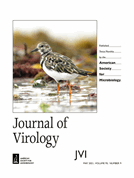Abstract Highly pathogenic avian Influenza virus (HPAIV) has spread in an unprecedented extent globally in recent years. Despite the large reports of cases in Asia, Europe, and North America, little is known about its circulation in South America. Here, we describe the isolation, and whole genome characterization of HPAIV obtained from sampling 26 wild bird… Continue reading Highly pathogenic avian influenza virus H5N1 clade 2.3.4.4b from Peru forms a monophyletic group with Chilean isolates in South America
Tag: Emerging Viruses
TWiV 1087: Should old infections be forgot
TWiV reviews rhinovirus complications in infants, a new influenza antiviral drug, Oropouche fever in Brazil, measles in Maryland and Ohio, effect of eliminating non-medical vaccine exemptions in NY, foot-and-mouth disease in Europe, severe primary and secondary dengue infections, and therapeutic mitigation of measles-like immune amnesia and exacerbated disease after prior respiratory virus infections. Hosts: Vincent Racaniello,… Continue reading TWiV 1087: Should old infections be forgot
Researchers uncover genetic factors for severe Lassa fever
AI SummaryResearchers have conducted a genome-wide association study (GWAS) on Lassa fever, a biosafety level 4 (BSL-4) virus. They identified two human genetic factors associated with severe Lassa fever and a set of LARGE1 variants linked to a reduced chance of contracting the virus. This research could pave the way for improved treatments for Lassa… Continue reading Researchers uncover genetic factors for severe Lassa fever
Previous Zika Infections Increase the Risk of Severe Dengue
AI SummaryThe research study highlighted the increased risk of severe dengue in individuals who have previously been infected with the Zika virus. The risk of hospitalization and severity of dengue is higher in individuals with a history of Zika infection. The study points to T cells and the immunological process called the “original antigenic sin”… Continue reading Previous Zika Infections Increase the Risk of Severe Dengue
Contribution of climate change to the spatial expansion of West Nile virus in Europe
AI SummarySummary: The article explores the contribution of climate change to the spatial expansion of West Nile virus (WNV) in Europe. Using ecological niche models, the study demonstrates an increase in the area suitable for WNV circulation from 1901 to 2019, attributing it to climate change. The study also highlights the influence of population density… Continue reading Contribution of climate change to the spatial expansion of West Nile virus in Europe
Macrophages derived from human induced pluripotent stem cells (iPSCs) serve as a high-fidelity cellular model for investigating HIV-1, dengue, and influenza viruses
Unraveling the architecture of poxvirus cores
A recent re-emergence and outbreak of Mpox brought poxviruses back as a public health threat, underlining an important knowledge gap at their core. Now, a team of researchers from the Institute of Science and Technology Austria (ISTA) lifted the mysteries of poxviral core architecture by combining various cryo-electron microscopy techniques with molecular modeling. The findings,… Continue reading Unraveling the architecture of poxvirus cores
Severe disease during both primary and secondary dengue virus infections in pediatric populations
AI SummaryThe article examines the severity of dengue infections in pediatric populations and challenges the belief that severe dengue is associated mainly with secondary infections. The study looked at 619 children with febrile dengue-confirmed infections in India and found that more than half of the severe cases and fatalities were from primary infections. The study… Continue reading Severe disease during both primary and secondary dengue virus infections in pediatric populations
Skin muscle is the initial site of viral replication for arboviral bunyavirus infection
Abstract The first step in disease pathogenesis for arboviruses is the establishment of infection following vector transmission. For La Crosse virus (LACV), the leading cause of pediatric arboviral encephalitis in North America, and other orthobunyaviruses, the initial course of infection in the skin is not well understood. Using an intradermal (ID) model of LACV infection… Continue reading Skin muscle is the initial site of viral replication for arboviral bunyavirus infection
Down to the core of poxviruses
A recent re-emergence and outbreak of Mpox brought poxviruses back as a public health threat, underlining an important knowledge gap at their core. Now, a team of researchers lifted the mysteries of poxviral core architecture by combining various cryo-electron microscopy techniques with molecular modeling.


